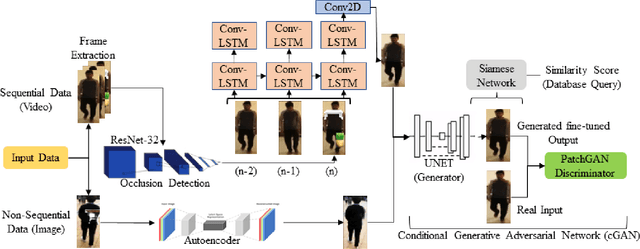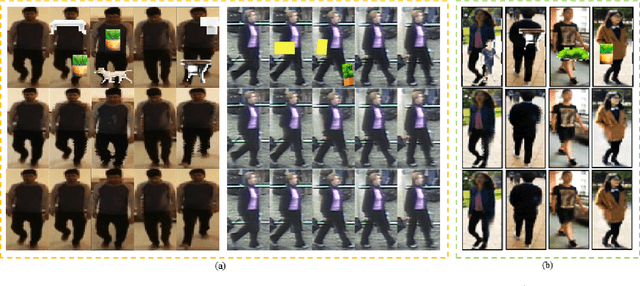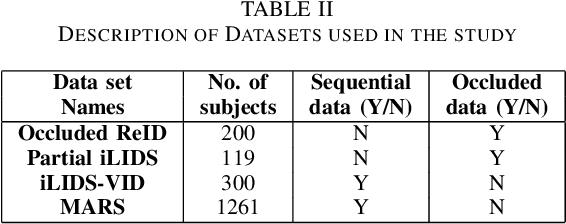Satyanarayana Vollala
A Novel end-to-end Framework for Occluded Pixel Reconstruction with Spatio-temporal Features for Improved Person Re-identification
Apr 16, 2023



Abstract:Person re-identification is vital for monitoring and tracking crowd movement to enhance public security. However, re-identification in the presence of occlusion substantially reduces the performance of existing systems and is a challenging area. In this work, we propose a plausible solution to this problem by developing effective occlusion detection and reconstruction framework for RGB images/videos consisting of Deep Neural Networks. Specifically, a CNN-based occlusion detection model classifies individual input frames, followed by a Conv-LSTM and Autoencoder to reconstruct the occluded pixels corresponding to the occluded frames for sequential (video) and non-sequential (image) data, respectively. The quality of the reconstructed RGB frames is further refined and fine-tuned using a Conditional Generative Adversarial Network (cGAN). Our method is evaluated on four well-known public data sets of the domain, and the qualitative reconstruction results are indeed appealing. Quantitative evaluation in terms of re-identification accuracy of the Siamese network showed an exceptional Rank-1 accuracy after occluded pixel reconstruction on various datasets. A comparative analysis with state-of-the-art approaches also demonstrates the robustness of our work for use in real-life surveillance systems.
Medical Image Segmentation using LeViT-UNet++: A Case Study on GI Tract Data
Sep 15, 2022



Abstract:Gastro-Intestinal Tract cancer is considered a fatal malignant condition of the organs in the GI tract. Due to its fatality, there is an urgent need for medical image segmentation techniques to segment organs to reduce the treatment time and enhance the treatment. Traditional segmentation techniques rely upon handcrafted features and are computationally expensive and inefficient. Vision Transformers have gained immense popularity in many image classification and segmentation tasks. To address this problem from a transformers' perspective, we introduced a hybrid CNN-transformer architecture to segment the different organs from an image. The proposed solution is robust, scalable, and computationally efficient, with a Dice and Jaccard coefficient of 0.79 and 0.72, respectively. The proposed solution also depicts the essence of deep learning-based automation to improve the effectiveness of the treatment
A Cognitive Study on Semantic Similarity Analysis of Large Corpora: A Transformer-based Approach
Jul 24, 2022



Abstract:Semantic similarity analysis and modeling is a fundamentally acclaimed task in many pioneering applications of natural language processing today. Owing to the sensation of sequential pattern recognition, many neural networks like RNNs and LSTMs have achieved satisfactory results in semantic similarity modeling. However, these solutions are considered inefficient due to their inability to process information in a non-sequential manner, thus leading to the improper extraction of context. Transformers function as the state-of-the-art architecture due to their advantages like non-sequential data processing and self-attention. In this paper, we perform semantic similarity analysis and modeling on the U.S Patent Phrase to Phrase Matching Dataset using both traditional and transformer-based techniques. We experiment upon four different variants of the Decoding Enhanced BERT - DeBERTa and enhance its performance by performing K-Fold Cross-Validation. The experimental results demonstrate our methodology's enhanced performance compared to traditional techniques, with an average Pearson correlation score of 0.79.
 Add to Chrome
Add to Chrome Add to Firefox
Add to Firefox Add to Edge
Add to Edge